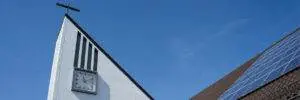Do You Know How to Spot Wind Damage on Your Roof?
In Colorado, we get more than our fair share of severe weather. Storms along the Front Range are a common cause of damage to homes—and especially roofs—in the area. And while hail is one of the most common storm-related sources of roof damage, high winds can create roofing issues as well, and the signs of wind damage to a roof are talked about less frequently.
This year tornados began touching down in Colorado in April, and since then we have seen numerous severe storms and tornados blowing through Denver and our surrounding areas. At Elite Roofing & Solar, our job is to keep our customers and local community informed about their roof and how to care for it. Whether your home was affected by this one of these severe weather events, or if you’re simply looking to prepare for spring and summer storms, here are some signs of wind damage to your roof to look out for.
Shingles Missing from Your Roof
The most obvious sign of wind damage to your roof is missing shingles. During the most severe storms, high winds can catch hold of shingles and tear them from your roof. This is especially common for older roofs, where shingles may have been loosened by previous storms or simply due to age.
Following a wind storm, take a walk around your property to see if you spot any gaps where shingles should be. Check the ground near your home to see if any shingles have fallen from your roof and into your yard. If you notice any shingles missing, contact a roofer immediately. Missing shingles leave your roof highly vulnerable to further damage and water penetration, and repairing the damage now will be much easier and cheaper than if you allow the issue to worsen.
Granule Loss and Lines on Shingles
Sometimes high winds cause damage without completely removing shingles from your roof. The granules on the exterior of asphalt shingles form a critical layer that helps to protect your home. While these granules typically erode over time, a severe wind storm can cause sudden and rapid deterioration that compromises your roof.
To identify granule loss, there are a few key things to check. If rain accompanied a recent wind storm, can check your gutters for a sudden accumulation of granules. You can also inspect the shingles themselves for signs of granule loss. While you shouldn’t walk around on your roof (especially following a storm), you can carefully look at your shingles from the safety of a sturdy ladder. Look for thin horizontal lines near the edges of your shingles, as this is a sign that the seal was broken and shingles were flapping in the wind.
Divots and Dents
While wind alone can cause damage to your home’s roof and exterior, it can also pick up debris and fling it against your house at high speeds. When this happens, your siding, windows, roof, and any other exposed part of your home’s exterior is at risk of damage.
One of the surest signs of debris damage due to wind is divots and dents appearing on your roof. Even if you don’t notice any marks on your roof, it’s a good idea to check the rest of your home. If you spot damage to your siding, gutters, fascia, or other portion of your home’s exterior, there’s a good chance your roof has been affected as well.
Elite Roofing Offers Free Storm and Wind Damage Inspections!
While it’s important for homeowners to know the signs of wind damage to a roof, oftentimes this damage is difficult to detect for those who aren’t roofing professionals. It’s a good idea to schedule a roof inspection if you recently experienced a wind storm in your area.
Here at Elite Roofing & Solar, we provide thorough storm damage inspections and repairs for homeowners throughout the Front Range. We know how to spot roof damage due to wind, hail, heavy rains, age, and much more. Contact us today to schedule your free inspection!



